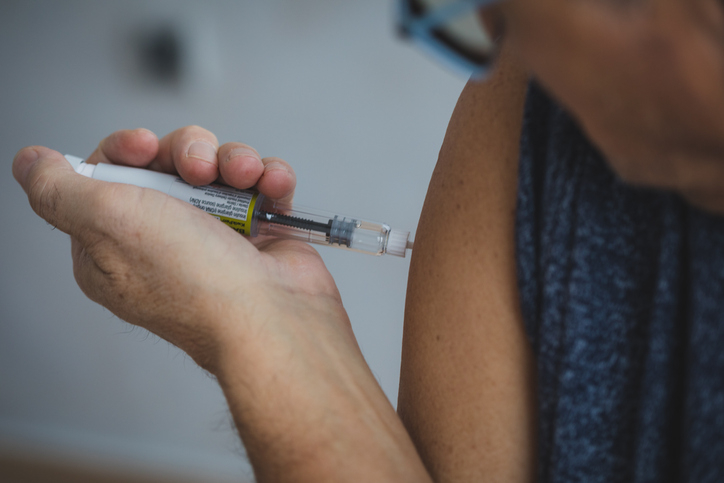Lantus insulin injection is a widely used medication for managing diabetes, specifically type 1 and type 2 diabetes. Developed by Sanofi-Aventis, Lantus is a long-acting insulin analog that helps regulate blood sugar levels throughout the day. In this comprehensive guide, we will delve into the details of Lantus insulin, its mechanism of action, usage, dosage, side effects, and other important considerations.
Contents
- 1 Understanding Diabetes and the Role of Insulin
- 2 What is Lantus Insulin Injection?
- 3 Mechanism of Action of Lantus Insulin Injection
- 4 Indications of Lantus Insulin Injection
- 5 Dosage and Administration of Lantus Insulin Injection
- 6 Side Effects of Lantus Insulin Injection
- 7 Precautions While Taking Lantus Insulin Injection
- 8 Conclusion
Understanding Diabetes and the Role of Insulin

Diabetes is a metabolic disorder that arises when the pancreas fails to produce enough insulin or when the body cannot utilize insulin properly. Insulin is a hormone that plays a central role in regulating blood sugar levels.
- Types of Diabetes:
- Type 1 Diabetes: This form results from the immune system mistakenly attacking and destroying the insulin-producing beta cells in the pancreas. Individuals with type 1 diabetes require insulin injections for survival.
- Type 2 Diabetes: In this type, the body either doesn’t produce enough insulin or becomes resistant to its effects. Type 2 diabetes is often associated with lifestyle factors such as obesity, lack of physical activity, and genetic predisposition.
- The Role of Insulin:
- Insulin Production and Release: Insulin is produced by beta cells in the pancreas. When we consume food, especially carbohydrates, the body breaks down these nutrients into glucose. In response to elevated blood glucose levels, the pancreas releases insulin into the bloodstream.
- Facilitating Glucose Uptake: Insulin acts as a key that unlocks cells, allowing glucose to enter and be used for energy. It plays a crucial role in regulating the amount of glucose in the bloodstream, preventing it from reaching excessively high levels.
- Storage of Excess Glucose: Insulin also facilitates the storage of excess glucose in the liver as glycogen. This stored glucose can be released when energy is needed between meals or during physical activity.
What is Lantus Insulin Injection?
Lantus insulin injection is a long-acting insulin analog used in the treatment of diabetes mellitus. Developed by Sanofi-Aventis, Lantus is a brand name for insulin glargine, a synthetic form of insulin. It is designed to provide a steady release of insulin over an extended period, typically up to 24 hours, helping to regulate blood sugar levels throughout the day and night.
Lantus belongs to the class of long-acting or basal insulins. Unlike short-acting insulins that are used to manage mealtime glucose spikes, Lantus is intended to provide a constant level of insulin to mimic the basal (background) insulin secretion pattern of the pancreas.
Mechanism of Action of Lantus Insulin Injection
The mechanism of action of Lantus insulin injection involves the unique properties of its active ingredient, insulin glargine. Furthermore, Lantus is a long-acting insulin analog designed to provide a basal level of insulin, mimicking the background insulin secretion pattern of the pancreas. Here’s a detailed explanation of how Lantus works:
- Insulin Glargine Structure: Lantus contains insulin glargine, a synthetic form of insulin. What sets insulin glargine apart is its modified structure. It has been engineered to be soluble at an acidic pH (such as that found in the vial or pen) and to form microprecipitates at a physiological pH (the pH of the body’s tissues).
- Subcutaneous Injection: Lantus is administered through subcutaneous injection, typically into the fatty tissue just beneath the skin. The injection site is chosen based on the healthcare provider’s recommendations and the patient’s preference.
- Formation of Microprecipitates: Once injected, the acidic environment of the injection site causes the soluble insulin glargine to form small microprecipitates under the skin. These microprecipitates act as a reservoir of insulin.
- Slow and Continuous Release: The microprecipitates release insulin very gradually over an extended period. This slow and continuous release is what gives Lantus its long-acting nature. Lantus is designed to provide a steady supply of insulin over approximately 24 hours, serving as a baseline or basal insulin.
- Stable Blood Sugar Control: The slow release of insulin from Lantus helps maintain stable blood sugar levels between meals and overnight. Furthermore, this is crucial for individuals with diabetes, as it provides a constant background level of insulin to regulate glucose and prevent excessive fluctuations in blood sugar.
Indications of Lantus Insulin Injection
Lantus insulin injection is prescribed for the management of diabetes mellitus in both adults and children. The indications for using Lantus are based on the individual patient’s needs and the healthcare provider’s assessment. Here are the primary indications for Lantus insulin:
Type 1 Diabetes:
- Lantus is commonly used in individuals with type 1 diabetes, a condition where the immune system attacks and destroys the insulin-producing beta cells in the pancreas.
- Since people with type 1 diabetes have little to no endogenous insulin production, they require exogenous insulin to manage their blood sugar levels.
Type 2 Diabetes:
- Lantus may also be prescribed for individuals with type 2 diabetes, especially when blood sugar levels are not adequately controlled with oral antidiabetic medications alone.
- In type 2 diabetes, the body either doesn’t produce enough insulin or becomes resistant to its effects. Lantus helps provide a basal level of insulin to manage blood glucose throughout the day and night.
Combination Therapy:
- Lantus can be used as part of a comprehensive diabetes management plan that may include a combination of different insulin formulations or other antidiabetic medications.
Individualized Treatment:
- The decision to prescribe Lantus is based on individual factors such as the patient’s age, weight, lifestyle, medical history, and response to insulin therapy.
- Healthcare providers tailor the treatment plan, including the choice of insulin type and dosage, to meet the specific needs of each patient.
Pediatric Use:
- Lantus is approved for use in children with diabetes, providing a long-acting insulin option for pediatric patients who require insulin therapy.
Dosage and Administration of Lantus Insulin Injection

The dosage and administration of Lantus insulin injections are individualized based on various factors, including the patient’s age, weight, blood glucose levels, and overall health. Furthermore, patients must follow their healthcare provider’s recommendations and instructions. Here is a general overview of the dosage and administration guidelines for Lantus:
- Dosage:
- Individualized Approach: The dosage of Lantus is determined on an individual basis. Healthcare providers assess factors such as the patient’s insulin sensitivity, glycemic control goals, and response to previous insulin therapy.
- Starting Dose: For individuals with type 1 diabetes or those transitioning from other insulin regimens, the starting dose of Lantus may be based on the patient’s total daily insulin requirements.
- Titration: Adjustments to the Lantus dosage may be made over time to achieve optimal glycemic control. Healthcare providers may recommend titrating the dose based on frequent blood glucose monitoring results.
- Pediatric Dosage: For children with diabetes, the healthcare provider will determine an appropriate starting dose and make adjustments as needed.
- Administration:
- Subcutaneous Injection: Lantus is administered subcutaneously, meaning it is injected just beneath the skin. Common injection sites include the thigh, abdomen, or upper arm. The injection site may be rotated to minimize the risk of lipodystrophy (changes in fat tissue).
- Timing: Lantus is typically injected once a day at the same time each day. However, the exact timing may vary based on the patient’s lifestyle and preferences.
- Do Not Mix with Other Insulins: Lantus should not be mixed with other insulins in the same syringe. It should be administered separately.
- Injection Devices: Lantus can be administered using insulin syringes, insulin pens, or insulin pumps. The choice of device depends on the patient’s preference and the healthcare provider’s recommendations.
Side Effects of Lantus Insulin Injection
Lantus insulin injection, like any medication, may cause side effects in some individuals. Patients need to be aware of potential side effects and promptly communicate any concerns to their healthcare providers. Common side effects are generally mild and often related to the injection site. Serious side effects are rare but can occur. Here is an overview of potential side effects associated with Lantus:
- Common Side Effects:
- Injection Site Reactions: It is common to experience mild and temporary reactions at the injection site, such as redness, swelling, or itching. These reactions usually resolve on their own.
- Hypoglycemia (Low Blood Sugar): Taking too much insulin, changes in diet, increased physical activity, or delayed meals can lead to hypoglycemia. Furthermore, symptoms may include shakiness, sweating, dizziness, confusion, irritability, and hunger.
- Weight Gain: Some individuals may experience weight gain while using insulin. This can be attributed to improved glycemic control and increased storage of glucose as glycogen.
- Less Common Side Effects:
- Allergic Reactions: Although rare, some individuals may be allergic to components of Lantus. Signs of an allergic reaction may include skin rash, itching, swelling, severe dizziness, or difficulty breathing. Seek immediate medical attention if any of these symptoms occur.
- Edema (Fluid Retention): In some cases, insulin therapy, including Lantus, may lead to fluid retention, causing swelling in the extremities.
- Serious Side Effects:
- Hypokalemia (Low Potassium): Insulin use, especially if not well-controlled, can lead to low potassium levels. Symptoms may include muscle weakness, irregular heartbeat, or cramping. Severe hypokalemia requires medical attention.
- Heart Failure: In rare cases, heart failure has been reported with insulin, particularly in patients with pre-existing heart disease.
- Vision Changes: Rapid improvement in glycemic control may cause changes in the refractive index of the eyes, leading to temporary changes in vision. This effect is usually reversible.
- Hypersensitivity Reactions: Severe hypersensitivity reactions, including anaphylaxis, may occur. Furthermore, these reactions require immediate medical attention.
It’s important to note that individual responses to medications can vary, and not everyone will experience the same side effects. Healthcare providers will carefully weigh the benefits of Lantus against the potential risks for each patient.
Precautions While Taking Lantus Insulin Injection

While Lantus insulin injection is an effective medication for managing diabetes, there are certain precautions that individuals should be aware of to ensure safe and effective use. Patients must follow their healthcare provider’s guidance and communicate openly about their health and any concerns. Here are some precautions to consider while taking Lantus:
- Inform Your Healthcare Provider: Keep your healthcare provider informed about your medical history, including any allergies, pre-existing conditions, or medications you are currently taking. This information helps your provider make informed decisions about your diabetes management.
- Hypoglycemia Awareness: Lantus can cause hypoglycemia (low blood sugar). Be aware of the symptoms of hypoglycemia, such as shakiness, sweating, dizziness, confusion, irritability, and hunger. Always carry a source of fast-acting carbohydrates, such as glucose tablets or juice, in case of hypoglycemia.
- Dosage Adjustments During Illness or Stress: Illness, stress, or changes in routine may affect blood sugar levels and insulin requirements. During such times, it’s essential to stay in close contact with your healthcare provider, who may recommend adjustments to your Lantus dosage.
- Regular Blood Glucose Monitoring: Regularly monitor your blood glucose levels as advised by your healthcare provider. This helps in assessing the effectiveness of Lantus and making any necessary adjustments to your insulin regimen.
- Injection Site Rotation: Rotate injection sites to minimize the risk of lipodystrophy (changes in fat tissue). Using the same injection site repeatedly can lead to lumps or indentations in the skin.
- Pregnancy and Breastfeeding: If you are pregnant, planning to become pregnant, or breastfeeding, discuss the risks and benefits of using Lantus with your healthcare provider. Furthermore, Insulin needs may change during pregnancy, and adjustments to the insulin regimen may be necessary.
- Avoid Alcohol Abuse: Alcohol can affect blood sugar levels and increase the risk of hypoglycemia. Furthermore, Limit alcohol consumption, and discuss alcohol use with your healthcare provider to determine its impact on your diabetes management.
- Regular Follow-Up Appointments: Attend regular follow-up appointments with your healthcare provider to assess your overall health, review blood glucose monitoring data, and make any necessary adjustments to your diabetes management plan.

